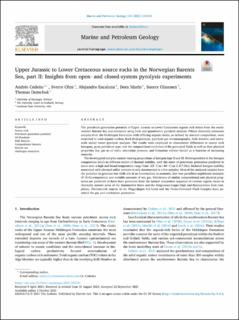| dc.contributor.author | Cedeno Motta, Andres Felipe | |
| dc.contributor.author | Ohm, Sverre Ekrene | |
| dc.contributor.author | Escalona Varela, Alejandro | |
| dc.contributor.author | Marin Restrepo, Dora Luz | |
| dc.contributor.author | Olaussen, Snorre | |
| dc.contributor.author | Demchuk, Thomas | |
| dc.date.accessioned | 2021-11-02T13:37:49Z | |
| dc.date.available | 2021-11-02T13:37:49Z | |
| dc.date.created | 2021-10-15T23:29:59Z | |
| dc.date.issued | 2021-10 | |
| dc.identifier.citation | Cedeño, A., Ohm, S., Escalona, A. et al. (2021) Upper Jurassic to Lower Cretaceous source rocks in the Norwegian Barents Sea, part II: Insights from open- and closed-system pyrolysis experiments. Marine and Petroleum Geology, 134, 105343 | en_US |
| dc.identifier.issn | 0264-8172 | |
| dc.identifier.uri | https://hdl.handle.net/11250/2827310 | |
| dc.description.abstract | The petroleum generation potential of Upper Jurassic to Lower Cretaceous organic rich shales from the southwestern Barents Sea was evaluated using bulk and quantitative pyrolysis analysis. Fifteen thermally-immature samples from the Hekkingen Formation with differing organic facies, as defined by maceral composition, were subjected to total organic carbon, Rock-Eval pyrolysis, pyrolysis gas chromatography, bulk kinetics, and micro-scale sealed vessel pyrolysis analyses. The results were employed to characterize differences in source rock kerogens, gross petroleum type, and the compositional evolution of the generated fluids as well as their physical properties (i.e. gas to oil ratio, saturation pressure, and formation volume factor) as a function of increasing maturity.
The investigated samples contain varying proportions of kerogen type II and III. Heterogeneities in the kerogen composition result in different orders of thermal stability, with the onset of petroleum generation predicted to occur over a high and broad temperature range from 123 °C to 144 °C (at 3.3C⁰/Ma). Reduced kerogen stability associated with elevated sulfur contents is only documented in a few samples. Most of the analyzed samples have the potential to generate low GOR oils of an intermediate to aromatic, low wax paraffinic-naphthenic-aromatic (P–N-A) composition and variable amounts of wet gas. Petroleums of similar compositional and physical properties are predicted to have been generated from the natural maturation sequence of various organic facies in thermally mature areas of the Hammerfest Basin and the Ringvassøy-Loppa High and Bjørnøyrenna fault complexes. Vitrinite-rich sources in the Fingerdjupet Sub-basin and the Troms-Finnmark Fault Complex have potential for gas and condensate generation. | en_US |
| dc.language.iso | eng | en_US |
| dc.publisher | Elsevier Ltd. | en_US |
| dc.rights | Navngivelse 4.0 Internasjonal | * |
| dc.rights.uri | http://creativecommons.org/licenses/by/4.0/deed.no | * |
| dc.subject | petroleumsgeologi | en_US |
| dc.title | Upper Jurassic to Lower Cretaceous source rocks in the Norwegian Barents Sea, part II: Insights from open- and closed-system pyrolysis experiments | en_US |
| dc.type | Peer reviewed | en_US |
| dc.type | Journal article | en_US |
| dc.description.version | publishedVersion | en_US |
| dc.rights.holder | © The Author(s) 2021 | en_US |
| dc.subject.nsi | VDP::Teknologi: 500::Berg‑ og petroleumsfag: 510::Geoteknikk: 513 | en_US |
| dc.subject.nsi | VDP::Matematikk og Naturvitenskap: 400::Geofag: 450::Petroleumsgeologi og -geofysikk: 464 | en_US |
| dc.source.volume | 134 | en_US |
| dc.source.journal | Marine and Petroleum Geology | en_US |
| dc.identifier.doi | 10.1016/j.marpetgeo.2021.105343 | |
| dc.identifier.cristin | 1946363 | |
| cristin.ispublished | true | |
| cristin.fulltext | original | |
| cristin.qualitycode | 1 | |

